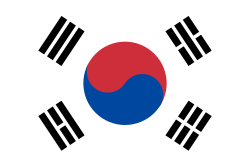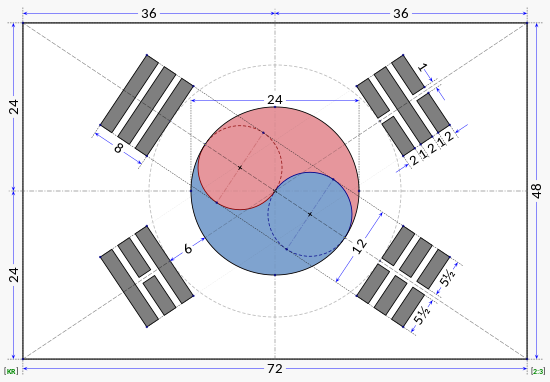Janubiy Koreya bayrogʻi

Janubiy Koreya bayrogʻi yoki Taegukgi (koreyscha: 태극기) Janubiy Koreyaning davlat ramzidir. Janubiy Koreya 1945-yilning 15-avgustida Yaponiyadan mustaqillikka erishgach, Taegukgini davlat bayrogʻi oʻlaroq qabul qilgan. Bayroq toʻgʻri toʻrtburchak shakldagi oq matoda aks etgan boʻlib, markazida qizil va koʻk tusli Taegeuk emblemasi joylashgan. Mazkur emblemani esa qora rangdagi toʻrt trigramma oʻrab olgan.
Xususiyatlari[tahrir | manbasini tahrirlash]
Konstruksiyasi[tahrir | manbasini tahrirlash]

Kok[tahrir | manbasini tahrirlash]
| Rang | Munsell[1] | CIE (x, y, Y)[1] | Panton[2] | Hex[1] |
|---|---|---|---|---|
| Oq | N 9.5 | — | — | #FFFFFF |
| Qizil | 6.0R 4.5/14 | 0.5640, 0.3194, 15.3 | 186 Coated | #CD2E3A |
| Koʻk | 5.0PB 3.0/12 | 0.1556, 0.1354, 6.5 | 294 Coated | #0047A0 |
| Qora | N 0.5 | — | — | #000000 |
Manbalar[tahrir | manbasini tahrirlash]
- ↑ 1,0 1,1 1,2 „ko:국기의 제작“ [Geometry of the National Flag] (ko). Ministry of the Interior and Safety (2017). Qaraldi: 2017-yil 6-avgust.
- ↑ „National Flag“. infokorea.ru. The Embassy of the Republic of Korea in Moscow. 2012-yil 18-yanvarda asl nusxadan arxivlangan. Qaraldi: 2017-yil 6-avgust.
Havolalar[tahrir | manbasini tahrirlash]
| Vikiomborda Janubiy Koreya bayrogʻi haqida turkum mavjud |

